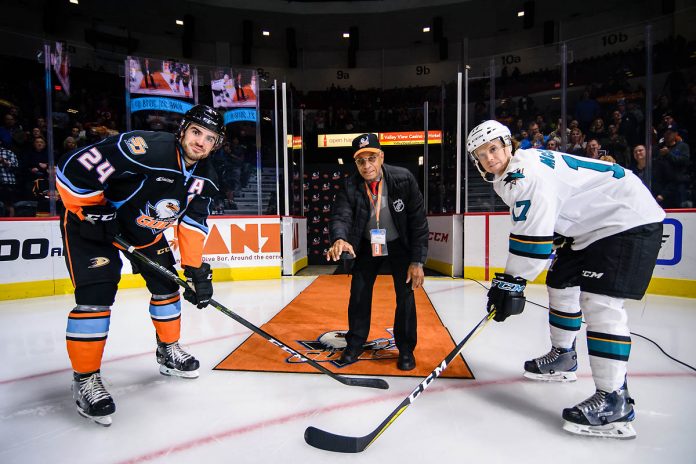
History speaks for itself. On Jan. 18, 1958, Willie O’Ree — a 22-year-old forward from Fredericton, New Brunswick, Canada — became the first black man to play in the National Hockey League when he suited up for the Boston Bruins in a game against the Montreal Canadiens at the Montreal Forum.
The game of hockey has certainly changed over the 60 years since O’Ree made his history-making debut. O’Ree — dubbed the “Jackie Robinson of hockey” — has helped forward that change.
The NHL consisted of just six teams — the Original Six — when O’Ree, a speedy winger, first touched the ice with his blades. NHL membership now stands at 31 teams with the addition of the Vegas Golden Knights this season and is as diverse as ever from a player standpoint.
Thirty countries can claim players in the NHL. There are 24 black players in the league this season.
But there was a time when hockey wasn’t so diverse — even when other major sports in North American had already broken the color barrier.
Since O’Ree’s barrier-shattering debut, 85 other blacks have played in the NHL.
P.K. Subban, a defenseman for the 2017 Stanley Cup finalist Nashville Predators and one of the league’s most prominent black players, called O’Ree a role model to any player from a different country or minority background.
O’Ree was the pioneer, and his legacy is one to be celebrated.
O’Ree, a longtime resident of La Mesa who is now 82, provided the showpiece for the San Diego Gulls’ inaugural Diversity Night on Jan. 20 when the American Hockey League club hosted the San Jose Barracuda.
The Gulls, the top developmental affiliate of the NHL’s Anaheim Ducks, celebrated Diversity Night to raise awareness of diverse groups in hockey and drive positive social change and foster more inclusive communities within the sport.
The Gulls recognized diverse groups throughout the game, including You Can Play, an initiative that works to ensure safety and inclusion for all who participate in sports, including LGBT athletes, coaches and fans; the San Diego Sled Hockey Team that is comprised of disabled and able-bodied athletes ages 14 and older, including active duty military and veterans; and the San Diego Chill, a non-profit organization dedicated to helping children with developmental disabilities play ice hockey.
The Gulls wore special diversity-themed warm-up jerseys that were later put up for auction for charity.
O’Ree, otherwise known as Mr. Hockey in San Diego, dropped the ceremonial puck.
It was the latest of many celebrations marking O’Ree’s 60th anniversary of breaking pro hockey’s color barrier.
He received a standing ovation, starting from the benches of the Bruins and Canadiens, when he walked out to center ice at TD Garden on Jan. 17 to drop the ceremonial puck one day shy of 60 years after becoming the first black player in the NHL.
NHL Commissioner Gary Bettman was on hand for the ceremony; the city of Boston proclaimed Jan. 18 as Willie O’Ree Day.
On Nov. 3, O’Ree was in Springfield, Mass., for ceremonies marking his breaking the color barrier in the AHL as well. It was on Oct. 12, 1957, that O’Ree became the first black player to skate in the AHL when he took the ice for the Springfield Indians in a game against the Buffalo Bison.
Three months later, O’Ree made his NHL debut with the Bruins.
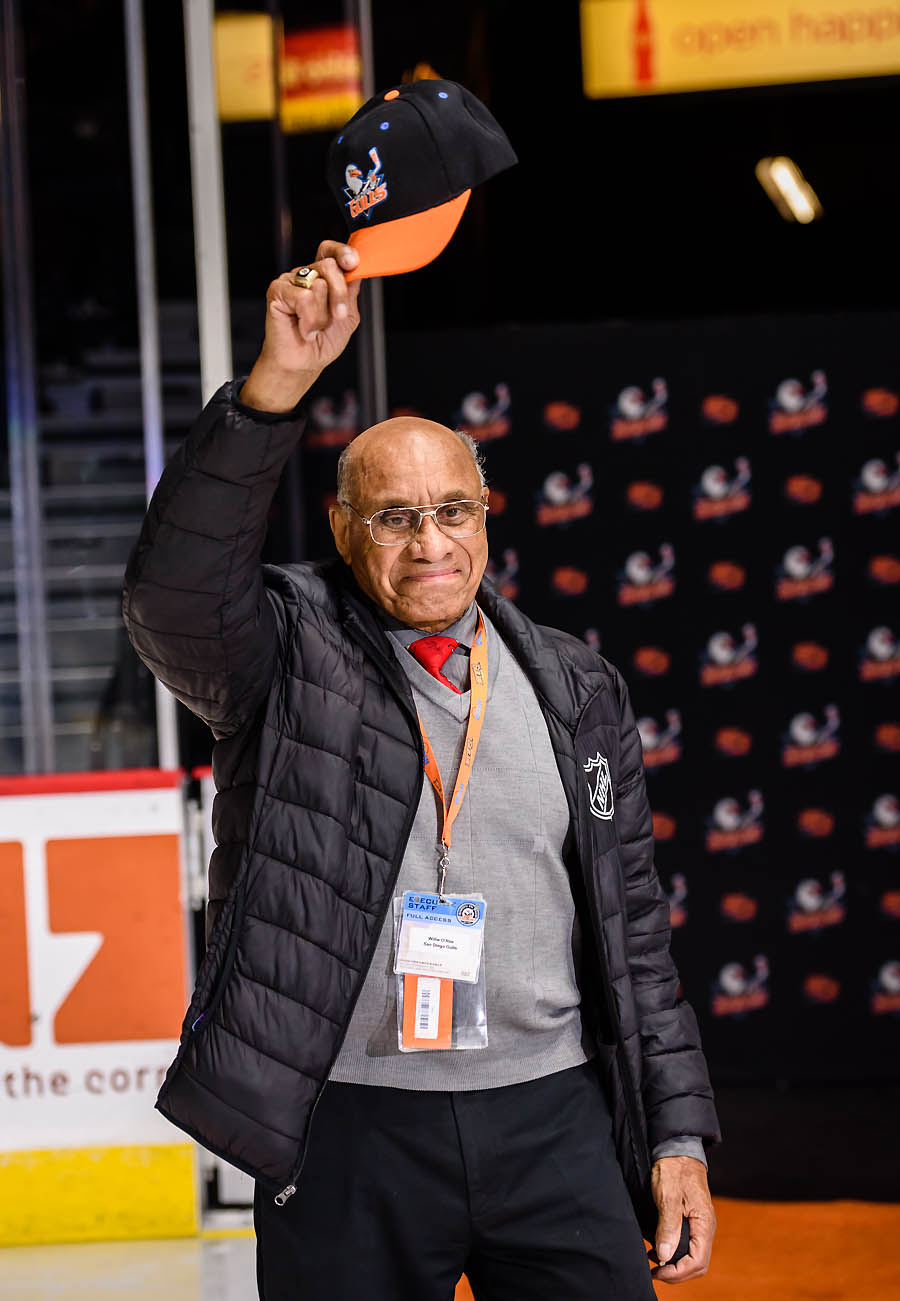
“It’s wonderful,” O’Ree remarked about the buzz marking his history-making feat. “I was thrilled when I was in Boston. It took me back to when I first came to the Bruins in their training camp in 1957. I kind of fell in love with the team and the entire Bruin organization.”
What does he remember about the history-making event?
At the time, O’Ree was playing for the Bruins’ minor league team, the Quebec Aces, in the Quebec Hockey League.
“The Bruins contacted the Quebec Aces, the team that I was playing for, and said they wanted me to meet the Bruins in Montreal to play two games – Saturday night in Montreal and Sunday in Boston,” O’Ree recalled.
“When I arrived in Montreal, coach Milt Schmidt sat me down and Lynn Patrick, the general manager, sat me down and said ‘Willie, we brought you up because we think you can add a spark to our club. You’re no stranger here to the Montreal fans and just play your game and have a good time and basically that’s what I did.”
O’Ree said Schmidt told him not to be concerned about “anything else.”
In fact, as far as O’Ree was concerned, he was just busy doing his job – being a professional hockey player.
It was only after reading newspapers the next day that he realized the significance of his first NHL call-up.
“It was the next morning that I found out that I did break the color barrier and opened doors for not only black players but players of color that are now playing in the NHL,” he said.
O’Ree drew praise for the manner in which he conducted himself in the face of racial prejudice as the only black player in the NHL in the 1960s. He was once asked to sit in the back of the bus during a visit to Georgia in 1956.
Fans hurled racial slurs at him during NHL games to try to knock him off his game.
It didn’t work.
In an article on Wikipeida, O’Ree noted that “racist remarks were much worse in the U.S. cities than in Toronto and Montreal,” the two Canadian cities hosting NHL teams at the time, and that “Fans would yell, ‘Go back to the South’ and ‘How come you’re not picking cotton?’ Things like that. It didn’t bother me. I just wanted to be a hockey player, and if they couldn’t accept that fact, that was their problem, not mine.”
According to the Wikipedia, NHL players are now required to enroll in a preseason diversity training seminar, and racially based verbal abuse is punished through suspensions and fines.
O’Ree’s NHL career lasted just 45 games over parts of two seasons and there would not be another black player in the NHL until the Washington Capitals drafted fellow Canadian Mike Marson in 1974.
But O’Ree would cement his legacy during a long and productive career in the Western Hockey League from 1961 to 1974 as a member first of the Los Angeles Blades (1961-67) and then the original San Diego Gulls (1967-74).
O’Ree won two scoring titles in the WHL and scored 30 or more goals in five seasons.
Blades head coach Alf Pike may have made the biggest contribution to O’Ree’s career when he shifted O’Ree – who had lost vision in his right eye due to a hockey injury during his junior hockey days — from left wing to right wing.
O’Ree’s offensive production jumped immediately — from 17 goals in 1963-64 to 38 goals in 1964-65 — to become one of the WHL’s most exciting players and prolific scorers.
Fans of the already wildly popular Gulls immediately fell in love with the speedy winger whose flashy full-speed rushes towards an opponent’s net drew excited shouts and cheers from crowds. O’Ree was a major reason the fledgling WHL franchise routinely saw home crowds soar past the 10,000 mark, the highest in North American minor hockey.
The WHL ceased operations following the 1973-74 season, but O’Ree came out of retirement to play one season with the San Diego Hawks in the Pacific Hockey League in 1978-79. At 43, he still proved he could contribute by recording 21 goals and 46 points in 53 games. He also logged 37 minutes in the penalty box.
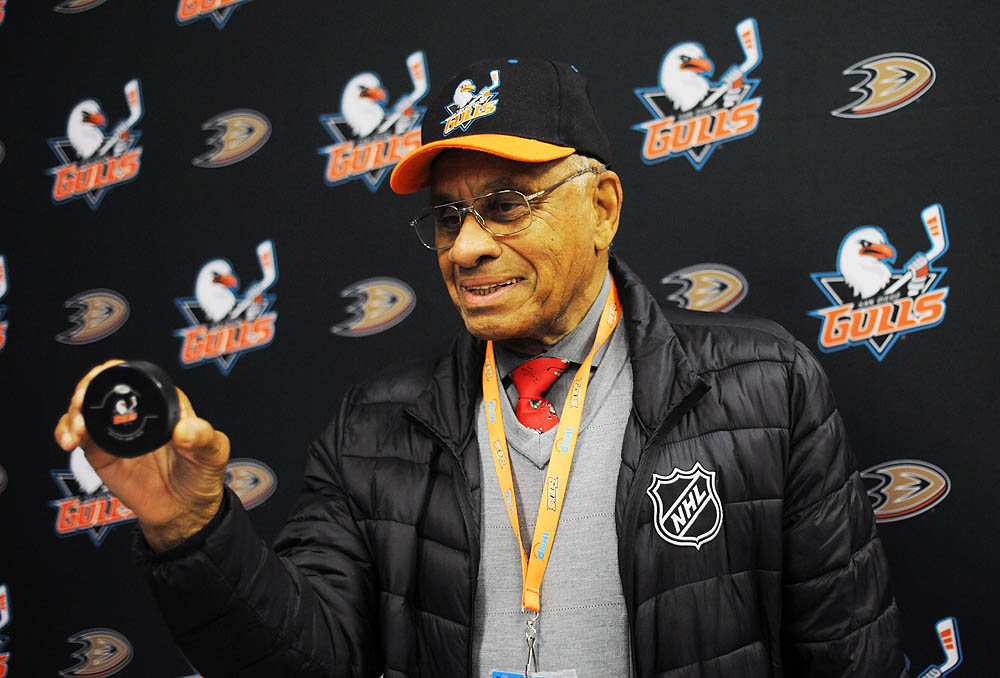
O’Ree remains tied to the game he began playing at age 5 in his native Canada.
He now serves as the NHL’s director of youth development, works with children to expand opportunities and preaches a message of inclusion in hockey.
“I’ve had about three titles since I came to the NHL,” O’Ree explained. “When I retired from hockey here in San Diego, I wanted to give back to the sport and give back to the community what hockey had given me for the 21 years I was able to play professional.
“When the NHL came calling in 1996 I was very happy. Now that I’ve been with the program for 20 years — the Hockey is for Everyone program — I just feel very pleased about having the opportunity to reach out and touch boys and girls to help set goals for themselves and help them play another sport where they haven’t had the opportunity to play before.”
It’s trailblazing efforts like that of O’Ree that has made hockey available to the masses and truly now a global sport.
The Sweetwater Union High School District sponsors the only CIF-sanctioned roller hockey league in the state. Diversity is apparent when one walks onto the court. Approximately half of district students speak a language other than English at home.
O’Ree has been one of the most well known ambassadors for the league’s Hockey is for Everyone initiative since 1998. The initiative uses the game of hockey – and the NHL’s global influence — to drive positive social change and foster more inclusive communities.
In his own words, when opportunity presents itself, the game grows.
“We have approximately 32 programs in the hockey initiative program,” O’Ree said. “The first thing I say is for these boys and girls to stay in school and get an education. Education is the key. You can’t go anywhere in the world these days without an education.
“As far as setting goals for yourself, you need to set goals for yourself. You need to work toward your goals and believe in yourself and feel good about yourself and like yourself. I’ve been doing this for 20 years and if I didn’t think the program worked I wouldn’t have stayed with it for 20 years. So just believe in yourself. If you think you can, you can. If you can’t, you’re right.”
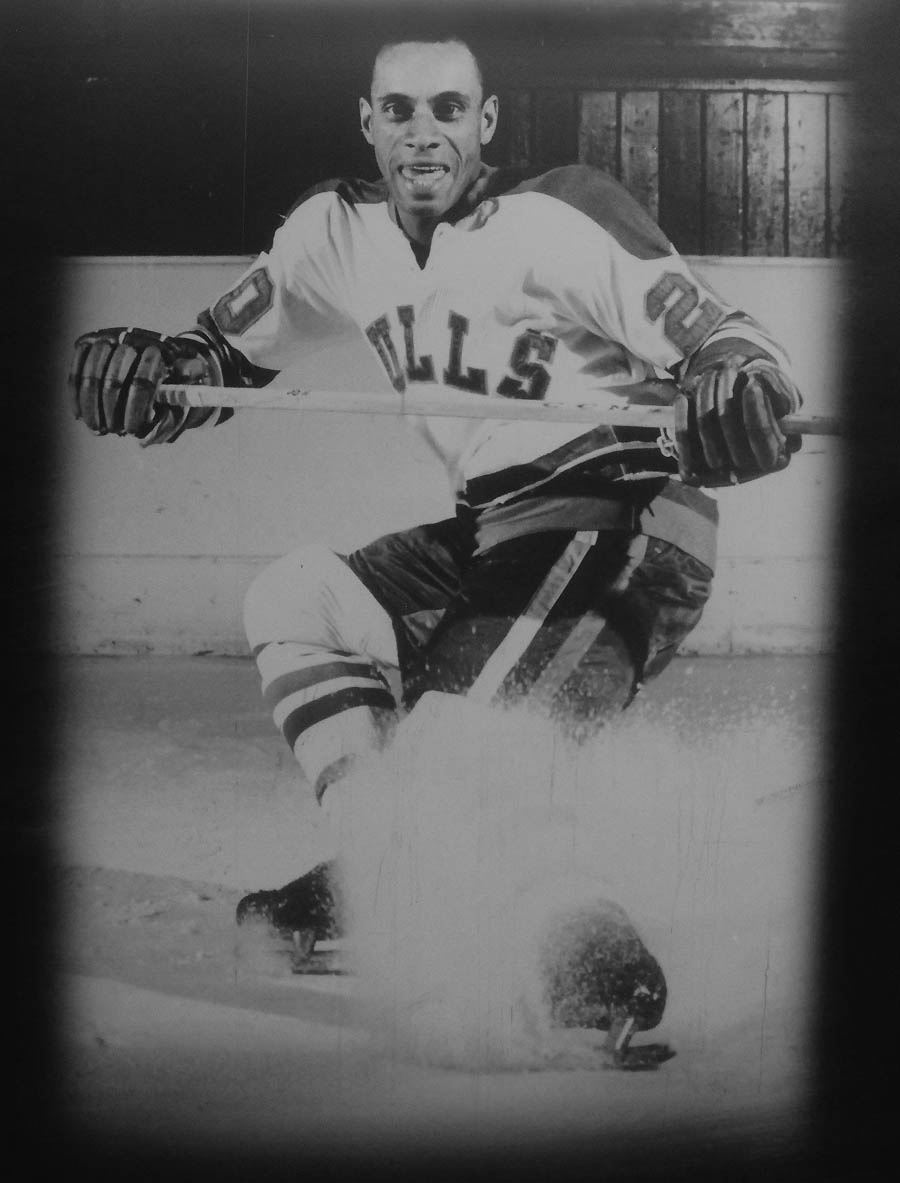
Making of a legend
O’Ree, the youngest of 13 children, began playing youth hockey in his native Fredericton in 1950-51 and was a graduate of the New Brunswick Amateur Hockey Association. He was known for his speed and checking ability and was a threat to score every time he touched the ice.
O’Ree began his junior hockey career with the Quebec Frontenacs in the QPJHL in the 1954-55 season where he scored 27 goals and picked up 44 points in 43 games. He moved to the Kitchener Canucks the next season in the Ontario Hockey Association where he scored 30 goals and collected 58 points in 41 games.
He joined the minor league Quebec Aces in the QHL in 1956-57 where he continued to prosper. He appeared in 69 games for the Aces his first season with the club, scoring 22 goals and 34 points.
He returned to the Aces for the 1957-58 season and played in a total of 57 games with 13 goals and 32 points.
It was during the 1957-58 season that he attended the Boston Bruins National Hockey League training camp and would later be called up to the Bruins for two games in January 1958 – appearances that would break the color barrier in the sport and forever change the face of the NHL.
O’Ree returned to the Aces for the 1968-59 season and played two seasons in the EPHL for the Kingston Frontenacs (1959-60) and Hull-Ottawa Canadiens (1960-61) before returning to the Bruins for 43 games during the 1960-61 season. He appeared in 43 games with four goals and 10 assists to his credit.
For O’Ree, that was the extent of his NHL career. Despite the subsequent scoring prowess he exhibited in the WHL, the NHL never came calling again.
O’Ree’s best statistical seasons came in 1968-69 when he scored 38 goals and accumulated 79 points in 70 regular season games to win the WHL scoring title.
He also scored 38 goals in 1964-65 with Los Angeles. He tallied 54 points in 54 games his first season in the WHL with the Blades in 1961-62.
O’Ree split time with the Gulls and the American Hockey League New Haven Nighthawks during the 1972-73 season.
The Gulls made the WHL playoffs in each of O’Ree’s seven seasons with the club. He added 19 more goals and 46 points in 40 playoff games.
O’Ree advanced to the WHL finals with the Blades during the 1963-64 season, losing in six games to the San Francisco Seals.
While O’Ree is known nationally for breaking hockey’s color barrier, he is known locally as being the most popular player in the history of the Gulls’ WHL franchise.
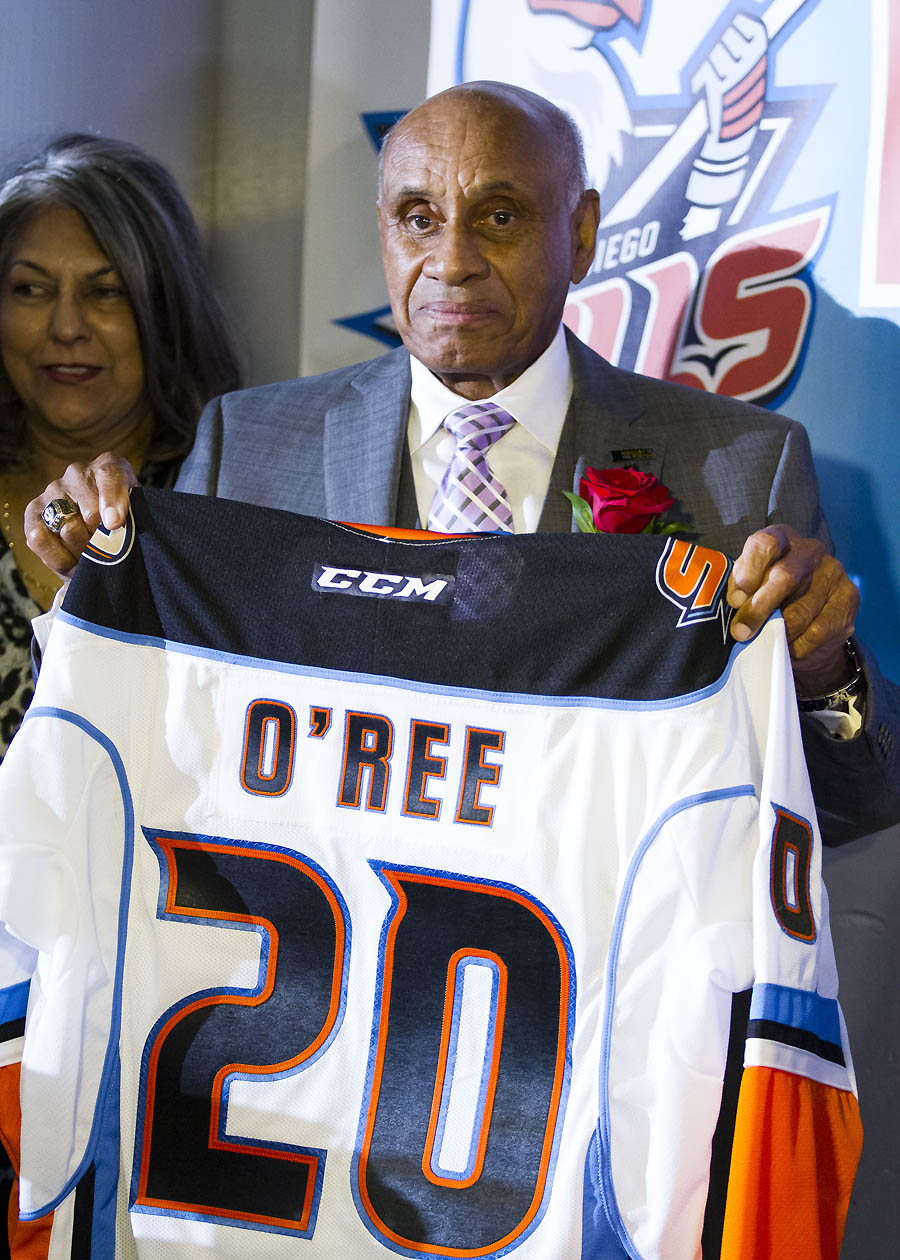
Protect the nest
One of the first items on the agenda of the AHL Gulls was to honor O’Ree by raising O’Ree’s famous No. 20 jersey number to the rafters of the Valley View Casino Center on Willie O’Ree Night during the team’s second home game in franchise history in October 2015.
While a banner hangs in the Valley View Casino Center emblazoned with No. 20, O’Ree said he didn’t want the actual jersey retired.
Forward Nick Ritchie wore No. 20 during the AHL Gulls’ inaugural season in 2015-16. Ritchie, who scored the first goal in the Gulls’ AHL franchise history, is now playing full-time with the Gulls’ NHL parent club in Anaheim.
Second-year defenseman Andy Welinksi will represent the Gulls in this weekend’s AHL All-Star Classic in Utica, N.Y. The two-day event features a skills challenge on Sunday, Jan. 28, and actual game competition on Monday, Jan. 29.
Welinski, 24, from Duluth, Minn., is a third round pick (83rd overall) in the 2011 NHL Entry Draft. He played four seasons at the University of Minnesota-Duluth before joining the Gulls for five games at the tail end of the 2015-16 AHL season.
He appeared in 63 games for the Gulls his rookie season in 2016-17 with six goals and 29 points to his credit to go with 16 penalty minutes. In 32 games this season, he has collected six goals and 22 points and is on pace to set a single-season record for offensive production.
He has appeared in four games with the Ducks this this season, registering a pair of assists.
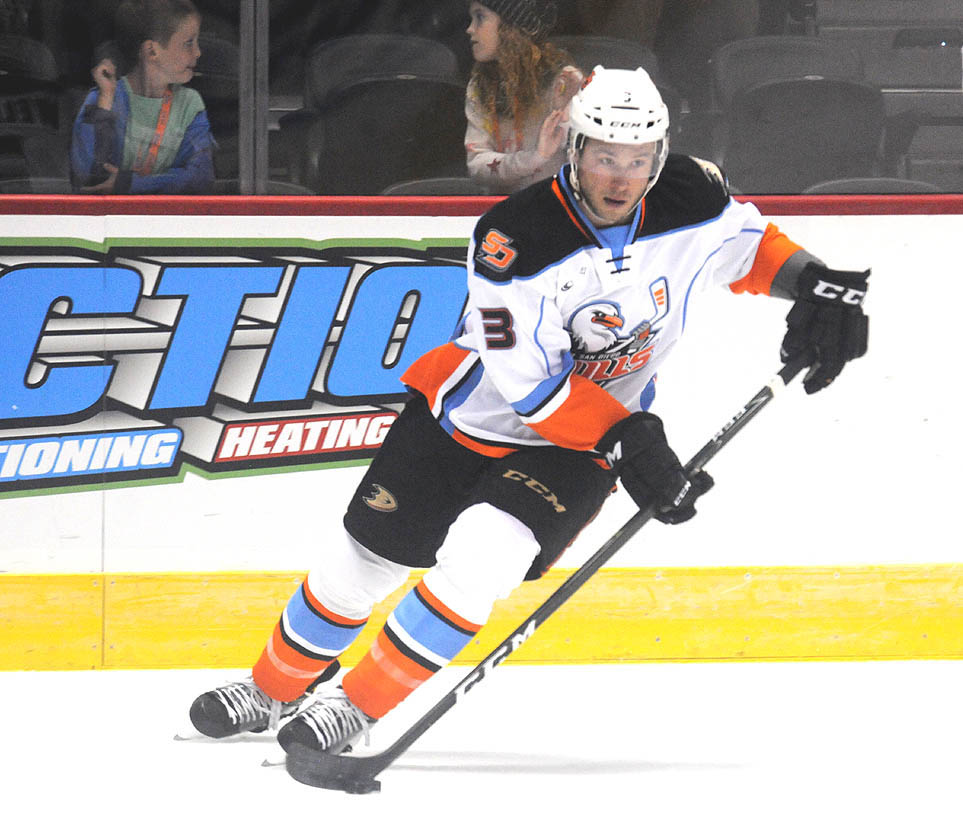
“It’s exciting,” Welinksi said about his upcoming appearance in the AHL All-Star Classic. “It’s something you don’t set your standards for each year because so few make it. You want to go out and be successful every day. I owe a lot to my teammates.”
Welinksi said confidence and poise were two key elements he learned to integrate into his game his rookie professional season.
“You want to be able to play without thinking too much, you want everything to be natural out there,” he said.
He said he also had to adapt to the speed of the game at the professional level. “The experience was important, getting more time on the ice helped make a difference,” he noted.
Welinski made his NHL debut in a Dec. 11 game against the visiting Carolina Hurricanes.
“It was exciting,” the Gulls blueliner related. “The first game was in Anaheim, so it was intense. But it definitely was busy. We went out on a 10- or 11-day road trip (after that). It was busy but it definitely was exciting.”
Welinksi’s return to the Gulls coincided with a run by the AHL team that featured 12 wins in a 15-game stretch.
The Gulls are currently battling to remain in playoff contention in the AHL’s Pacific Division for the 2018 Calder Cup playoffs. The Gulls have advanced to the division finals in each of their prior two seasons in San Diego.
“We were playing well before the Christmas break and we want to get back to that comfort level,” Welinski explained. “I think we’re getting back there.”
His goals for the second half of the season mirror those of his teammates and expectations of head coach Dallas Eakins. “I want to work hard and be an important player for my team,” Welinksi said.
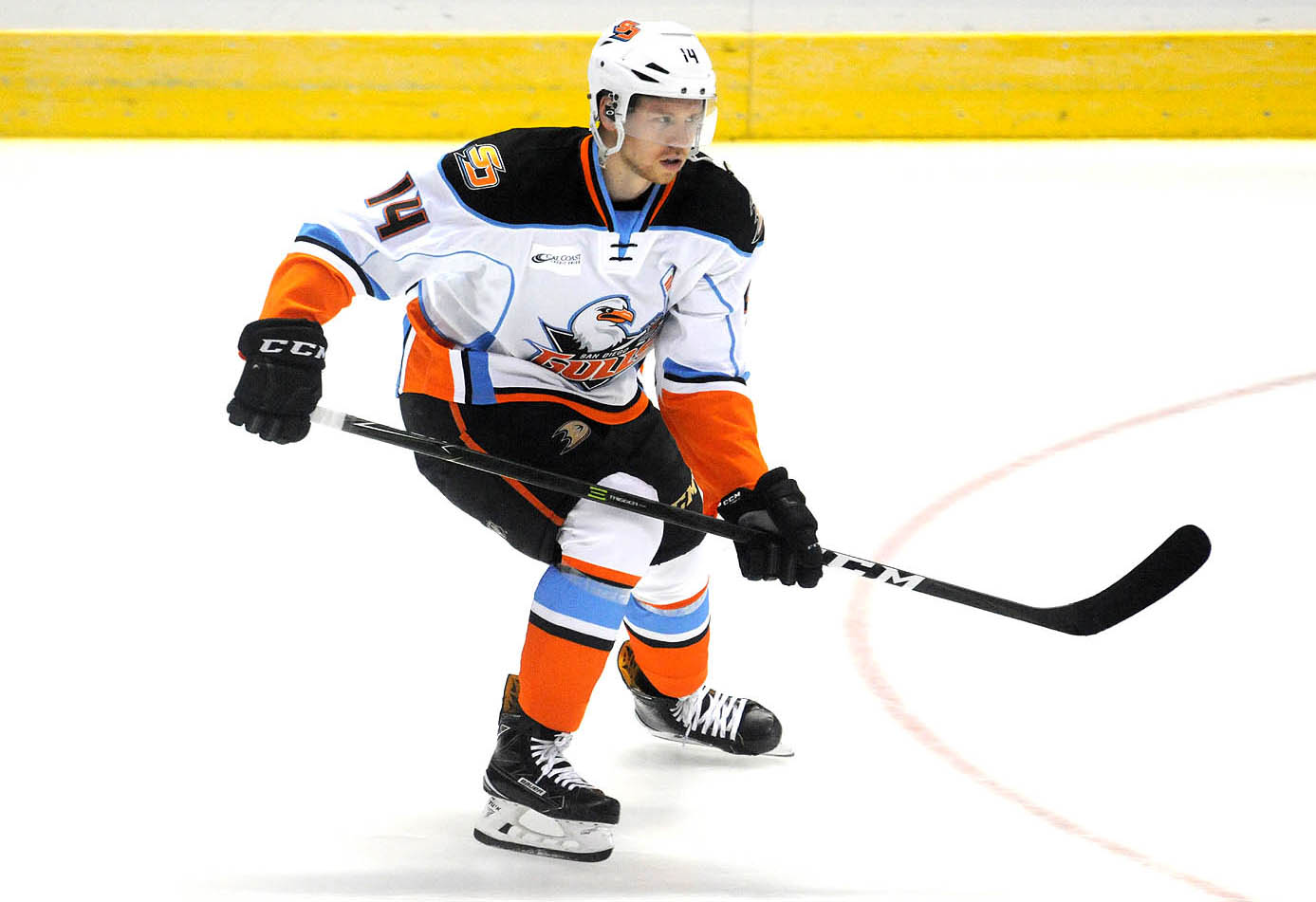
Forward Kalle Kossila earned honors as CCM/AHL Player of the Week honors for the period ending Jan. 7 after recording seven points (one goal, six assists) in three games — all Gulls victories.
On Jan. 3, the 24-year-old native of Kauniainen, Finland, set a franchise record with four assists and tied the team mark with four points as San Diego recorded a 4-3 victory at the Texas Stars. On Jan. 5, he tallied a goal and an assist as the Gulls returned home and shut out San Jose 5-0. In a rematch with the Barracuda on Jan. 6, Kossila notched another assist during San Diego’s 3-2 victory– the team’s 100th in San Diego.
Six of Kossila’s seven points during the three games came on the power play as the Gulls went 9-for-12 with the man advantage (75.0 percent) in the three games.
A second-year pro out of St. Cloud State University, Kossila leads the Gulls in scoring with 30 points (nine goals, 21 assists) in 26 contests this season, while adding one goal and one assist in 10 appearances with the NHL’s Anaheim Ducks.
He notched 14 goals and 34 assists in 65 games with San Diego as a rookie in 2016-17, and has totaled 25 goals and 56 assists for 81 points in 92 career regular-season AHL games. Kossila signed as a free agent with Anaheim on Mar. 30, 2016.
The Gulls honored Kossila with his own Bobblehead Night on Jan. 19. The game attracted a sellout crowd of 12,920 fans.
The Gulls continue to lead the 30-team AHL with a 9,344 attendance average.
Scott Hopkins contributed to this story.
